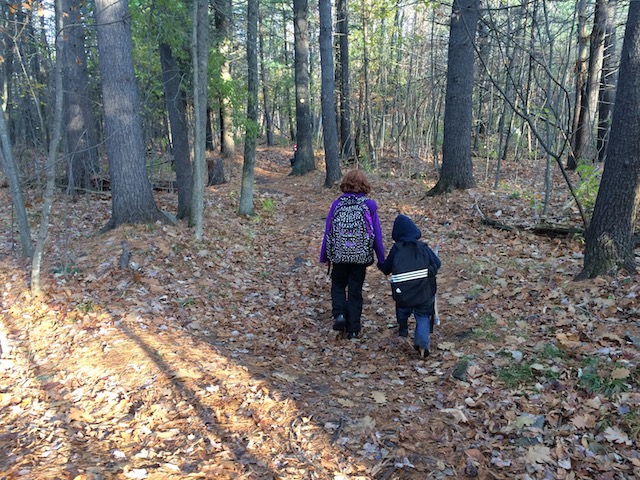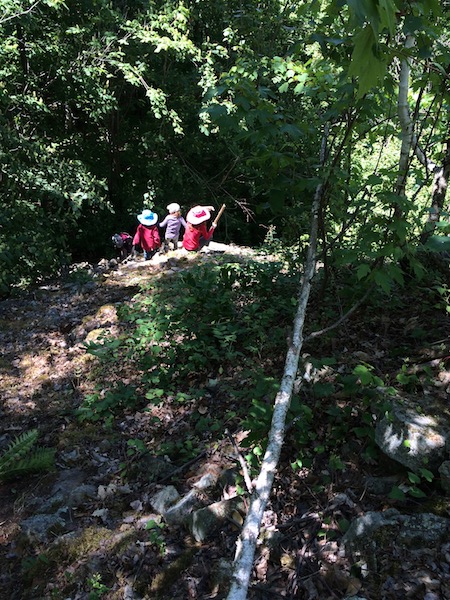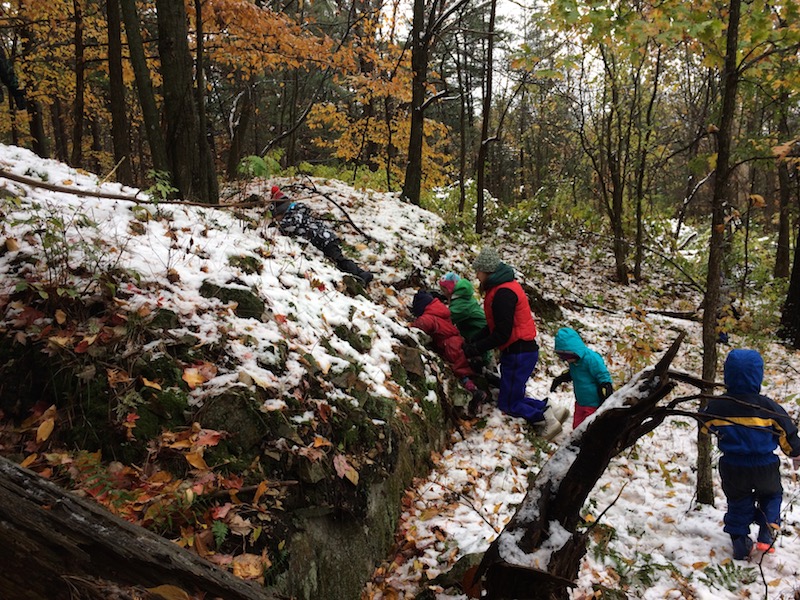
by Sonja Lukassen, Lead Educator and Manager Regional Programs, Ottawa Forest and Nature School
It all started when a boy decided to run up his double ramp, then jump off the end of it, rather than walking. The boards came down with a crash. I asked “Did you see how the boards moved differently when you ran and jumped rather than walking?” That was it. He started moving boards, experimenting, testing hypotheses. His investigations were so hefty and noisy, of course many other children felt compelled to join in. Every available plank needed to be stacked. Stumps and logs needed to be shifted and balanced. There was a lot of hard work going on- physical labour, deep communication, some persuasion to acquire more materials, considerations for each other’s and one’s own safety.
A preschooler was watching intently, and when there were at least 6 people sitting on the creation he decided he wanted to join them. We held the creation steady. He tried to scale the side of the planks but he stepped back, saying there wasn’t enough room for his feet to step. The child at the low end offered to move so that his new friend could climb up that way. He tried, asked for my hand as he climbed, paused, and climbed down. I asked him his plan. He told me he wanted to climb but it felt too scary. We waited. Another child brought him a stump to step up on, as a ladder up. Again, he tried, asked for my hand, paused and climbed down. I asked his plan again. He said he wanted to climb on top of the creation but it felt too scary, like he might fall, so didn’t want to.
He took a step back and watched as another child, the one who had brought the stump for him, climbed up onto the planks. This boy said it was easy to climb up- he wanted to try for himself and to show his younger friend how it could be done. I reminded the group that what feels easy for one person might feel hard for another, that we all need to listen to our bodies and brains when we get a message to slow down, to climb down, to stop a certain activity because of how we feel.
The balancing, testing, climbing, wobbling, of this creation continued for quite a while longer, with various children coming and going to add their piece to the play.
I’ve had this same conversation with countless children, and with a great number of adults, too. Taking a risk looks different for each individual, and shifts based on a great variety of factors. The need to listen to our bodies and brains remains the same- if something doesn’t feel right, it makes sense to pause and take a closer look. If something does feel right, if it feels safe and fun and perhaps even exciting, go for it.
In 2015 the ParticipACTION Report Card on Physical Activity for Children and Youth offered hard evidence supporting free play outdoors which led to the following statement:
“Access to active play in nature and outdoors- with its risks- is essential for healthy child development. We recommend increasing children’s opportunities for self-directed play outdoors in all settings- at home, at school, in child care, the community and nature.”(Follow this link to find the entire position statement)

I appreciate having research to back up the work that I do supporting interest-led, emergent, risky outdoor play. I know in my gut that there is value to setting children free outside- I see it in my work, with my family, and in myself. Time outside is beneficial in so many ways.
This means different things for different people. I’ve known parents who happily watch their children play barefoot in puddles, laughing as the children tumble into the muck. I’ve talked to a mom who struggled to let her child take a step up a slide (because it was built for children to go down), and a dad who needed to have an ongoing discussion about whether or not there really was value in walking through a puddle.

I am grateful for the willingness these parents have to take on these discussions. They see and feel the value in making space for their children to lead their own play, they often have memories of magical childhood explorations, and they are journeying to bring the two together. Some children have the opportunity and inclination to climb high, to splash deep, to roll and run and jump in the forest. Some children have fewer opportunities, and tend to make milder choices when it comes to taking risks in their play. Both are just right. There is no specific way that we, children and adults, should be outside. What matters is making time and being outside, in the wilds or in nearby-nature- together, for a fair chunk of time, as often as we can make it happen.

Ontario Parks values this unstructured time, outside in nature, and they are inviting everyone to visit their nearest Ontario Park. Friday, July 21, is Healthy Parks Healthy People Day, and admission to all Ontario Parks is free. (Visit their website for more information.) We are pleased to endorse this initiative, and invite all of our readers to make time to be outdoors this week and always, exploring, playing, and taking risks together.

